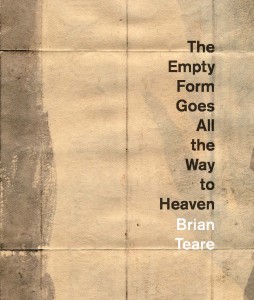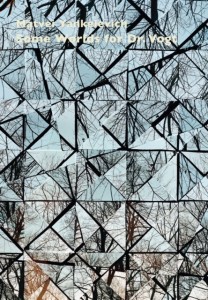Book Review
Two Recommendations from the Poetry Reviews Editor:
The Empty Form Goes all the Way to Heaven & Some Worlds for Dr. Vogt
When I first encountered Agnes Martin’s paintings, those grids too easily subsumed by the name Minimalism, I felt a mute appreciation. But over the years I’ve found myself, in every museum I visit, searching out her work, feeling not a mute appreciation on discovering one, but a sense of nearly inexplicable relief. Easy to dismiss the grid as an impersonal geometry; truer to see it as an emblem of our most personal efforts to grasp the nature of finding ourselves living within a world that requires our interpretation to fully dwell in it. Then those lines of the hand-drawn grid offer themselves as a form of pure contradiction—horizontal and vertical—whose purity might best be seen as the fundamental rational effort to lay down between ourselves and what we see a pattern thought which we might be able to describe our vision. Imagine those wooden lattices Renaissance painters used to portion out their canvas, and you get one sense of the grid’s representational aid; but Agnes Martin isn’t painting any scene. Her grids portion out forms of emptiness. And so she gives to us a picture of our deepest philosophic condition. How do I find meaning in nothingness? I make it.
 Brian Teare’s newest book, The Empty Form Goes All the Way to Heaven, beautifully produced in an oversize volume by Ahsahta Press, takes for the title of every one of its poems a fragment of language from Agnes Martin’s writings, or the physical description (media, size) of one of her works. But there is a far deeper mimesis here occurring than mere homage. Teare—one of his generations finest lyric poets and truest formal experimenters—seeks, poem by poem, a way to participate on the page the work of Martin’s grids, writing in each poem a number of discrete poems that work in and through and against each other, showing a simultaneity of thought and experience, each poem its own, and each poem broken apart by the larger work of all. The concern of the whole book focuses on a long, undiagnosed illness the poet suffered, marked by terrible nausea, headache, pain, and worse, the ceaseless suffering that obliterates thought, beauty, poems, art, even one’s sense of oneself.
Brian Teare’s newest book, The Empty Form Goes All the Way to Heaven, beautifully produced in an oversize volume by Ahsahta Press, takes for the title of every one of its poems a fragment of language from Agnes Martin’s writings, or the physical description (media, size) of one of her works. But there is a far deeper mimesis here occurring than mere homage. Teare—one of his generations finest lyric poets and truest formal experimenters—seeks, poem by poem, a way to participate on the page the work of Martin’s grids, writing in each poem a number of discrete poems that work in and through and against each other, showing a simultaneity of thought and experience, each poem its own, and each poem broken apart by the larger work of all. The concern of the whole book focuses on a long, undiagnosed illness the poet suffered, marked by terrible nausea, headache, pain, and worse, the ceaseless suffering that obliterates thought, beauty, poems, art, even one’s sense of oneself.
The poems are no mere documents of this ordeal. They are demonstrations of the mind and body in their crisis—and as reading a given poem might feel as if the poem, in its contrasting parts, is struggling to learn to read itself, so the poet himself is turned into a page:
between her hands
the healer makes
my skull a page
Perhaps it’s the case that long suffering leads one to the realization that you can no longer read yourself, and a healer—like art—is the one who takes the corrupt text of the diseased body and finds what language remains, learns to speak that language, works so as to read what is there still to be read, and in an act of utmost kindness, tells the patient the nature of the text that is himself. And that text isn’t isolate; it’s in the world:
no body a closed border
imbalance enters my body
the lyric a part of its pattern
Imagine the lyric poem as the ongoing effort to find a balance between order and chaos, and suddenly, the poetic effort continually demonstrates for us the agony of maintaining a shape called life. The mind is not enough to grasp the riddle, and so these poems often act as koans, zen-like reflections that through paradox bring us near to that indescribable field life performs itself upon—like a grid placed over vastness:
a thought
keeps creating
the mind
claiming it exists
Life makes a similar claim, the body insisting it exists, and doing so no more necessarily than when the claim feels threatened. Teare’s book does something far more important than offer itself as a document of illness and recovery. It shows us what the mind and body in pain strive after when it seeks in art not a solution to suffering, nor a consolation, but a way to continue, to see if not to wholly understand, how to be free of suffering while suffering all the while.
 “Cause and effect are two sides of one fact,” writes Emerson. I might say the same of Matvei Yankelevich’s Some Worlds for Dr. Vogt in relation to Brian Teare’s book. Whereas Teare’s work turns so far inward as to invert and reach out, so the fabulist imaginative reach of Yankelevich’s new volume reaches out so far it inverts and offers the intimate topography of a poet’s deep imaginative life.
“Cause and effect are two sides of one fact,” writes Emerson. I might say the same of Matvei Yankelevich’s Some Worlds for Dr. Vogt in relation to Brian Teare’s book. Whereas Teare’s work turns so far inward as to invert and reach out, so the fabulist imaginative reach of Yankelevich’s new volume reaches out so far it inverts and offers the intimate topography of a poet’s deep imaginative life.
Comprised of forty-five shorter lyric poems, Yankelevich takes upon himself, with playful seriousness, “the observation / of observation.” Wearing its conceptual life lightly but never frivolously, again and again, these poems posit worlds against the blank page:
A new world springs up where the old world
nearly leaves off.
There’s something coy in those worlds “new” and “old,” blurring the line between historical reference and phenomenal exploration. Edging up against language as received meaning, as ideology, as readymade, these poems secret within themselves that demagogic effort in which the poet mimics the world-making power lurking underneath the absurd fact of his own existence:
Pose a world as tautology, or an equilibrium—
a state of balance, or static. Something like
the river flows—already redundant. What
in fact is its shape? For instance, someone
gave you this beer and you can’t do anything
about it. You can drink it as long as you stand
relatively still, describing to yourself the view
or the way the tree trunks lay in the northern
woods, leafless then, save for the ground cover,
so that vision is not a noun, but the un-
achievable form of the verb reading.
A strange paradox—that one must write the world one wants to read, must observe observation to know the work is being done or somehow doing itself before your eyes, must borrow a language from the only words we have, in order to imagine a new world that can only come into focus only by referencing this one. So quietly, and so quirkily, Yankelevich brings his readers into poetry’s deep phenomenal work, in which reality itself is the thing about which the question need be asked, and the only way to ask it, is to imagine other worlds, each somewhat similar to this one in which we live, but built foremost of the imagination, that activity the departs from reason to gain a better hold on possibility.
And it is in a sense of nearly magical possibilities, of world-making and vision-as-verb, that Some Worlds for Dr. Vogt leaves its readers:
These worlds, the points where branches meet
in the removal of the depth-of-field, are—as the stars
map endpoints in a chart of lines—no more
than serifs snapped on tips of invisible letters.
With the subtle humor underlying the mystical urge informing these poems, Yankelevich attunes us again to a sense of the world too easily laughed at or shrugged off, in which the stars mark cosmic maps, and the stems and buds and branches of trees are each their own sigil, teaching us with abiding patience to read the world that is ours.
About the Reviewer
Dan Beachy-Quick, Colorado Review Poetry Reviews Editor